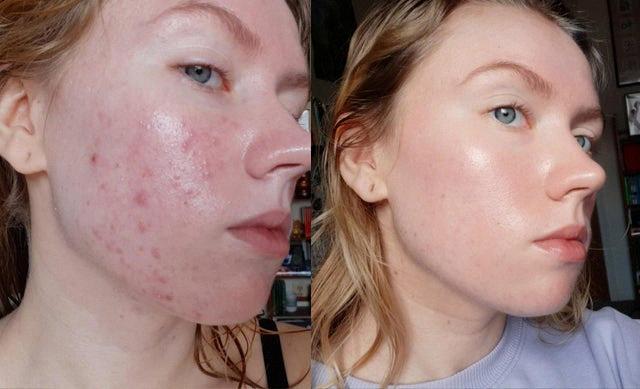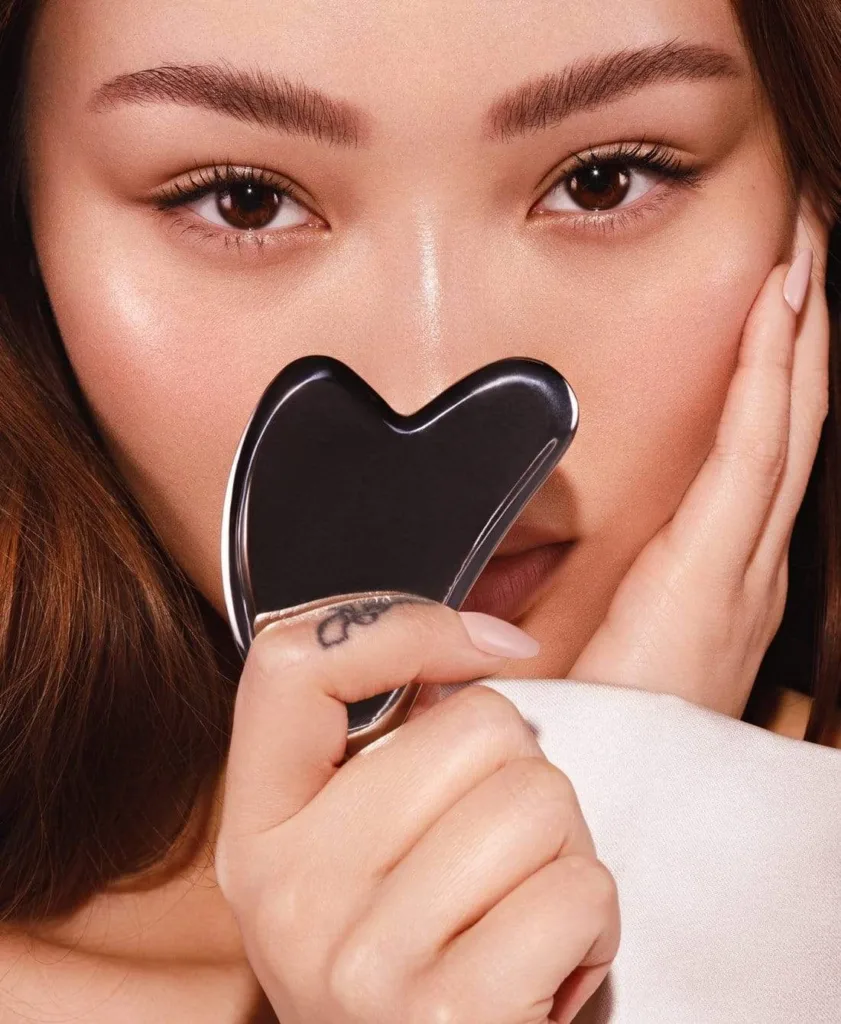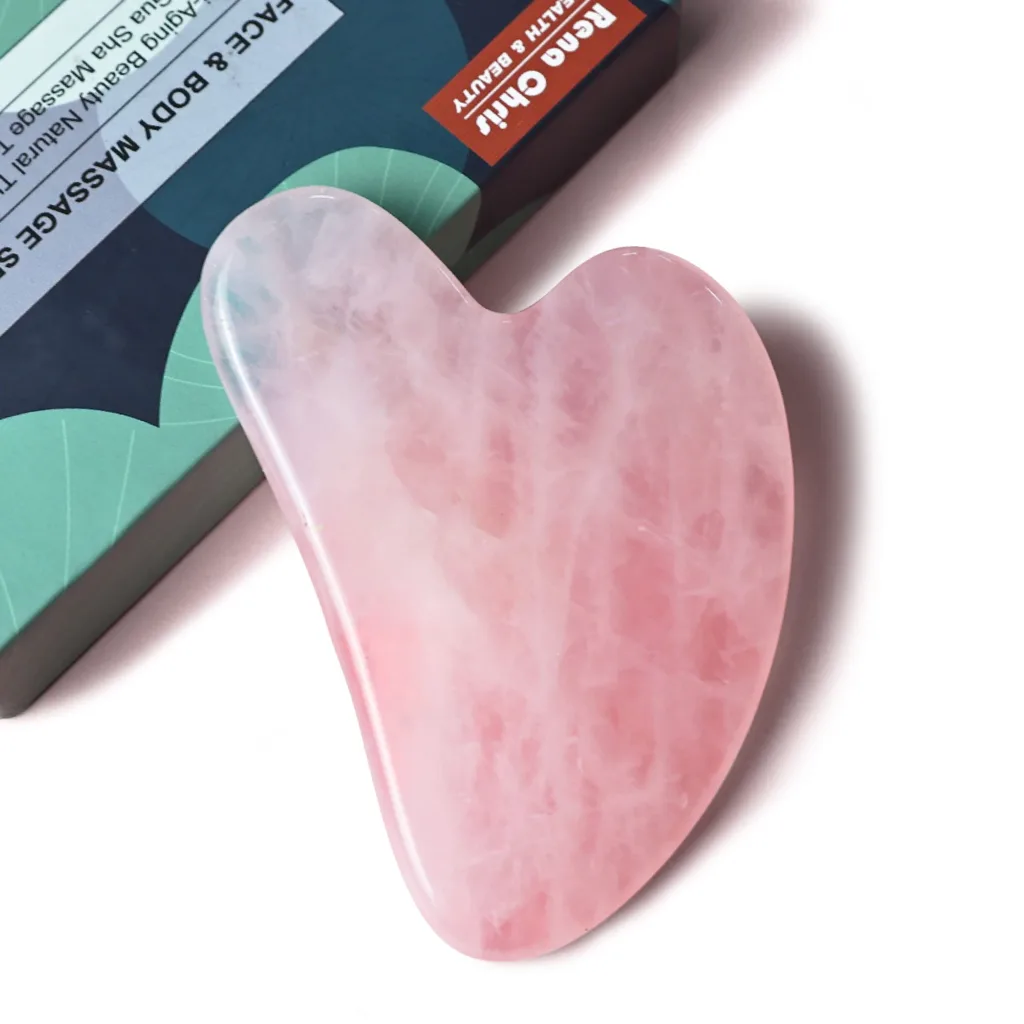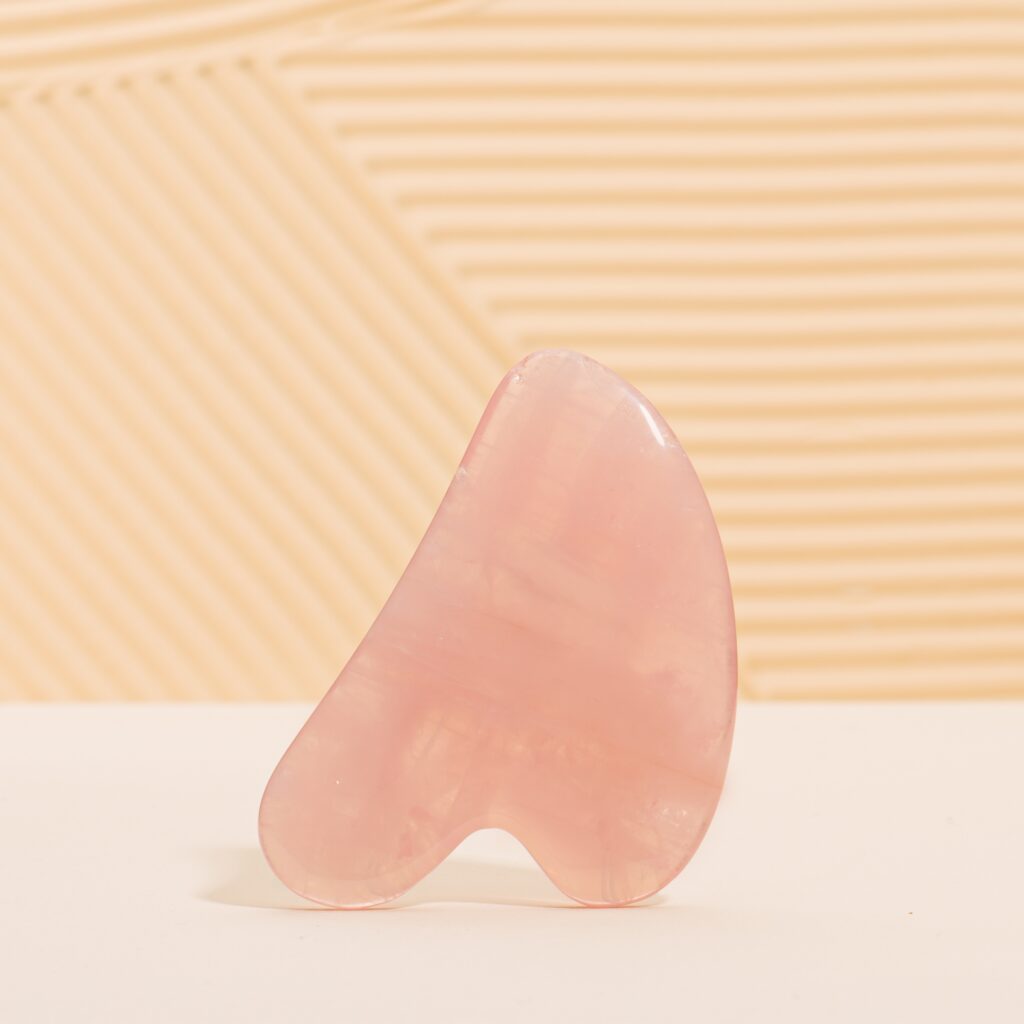Gua sha, a traditional Chinese medicine technique that involves scraping the skin with a smooth-edged tool, has gained popularity in recent years for its potential benefits in promoting lymphatic drainage, reducing inflammation, and improving circulation. However, some people may experience breakouts after trying gua sha for a few consecutive days. In this blog post, we’ll explore the possible reasons behind gua sha breakouts and how to avoid them.
Firstly, it’s important to understand that gua sha is not recommended if you suffer from cystic acne or open lesions. The pressure applied during the gua sha technique can potentially aggravate these conditions and cause further irritation. If you have these skin issues, we recommend using the Jade Roller instead, which applies a gentler pressure and stll encourages lymphatic drainage.
Another possible reason for gua sha breakouts is the technique itself. It’s essential to use downward strokes starting from the jawline and ending at the clavicle to avoid pushing the lymphatic fluid back into the face, which can cause breakouts. Also, it’s crucial to use a light pressure and not to overdo the scraping. Remember, gua sha is not a competition, and the goal is not to see who can make the most red marks on their face.
Moreover, it’s important to avoid combining gua sha with aggressive exfoliation, especially if you have sensitive skin. Doing so can cause further irritation and redness, leading to breakouts. Similarly, it’s best to avoid gua sha if you have rashes, sunburns, or blood coagulation issues, as the technique can potentially worsen these conditions.
Lastly, it’s worth mentioning that your skin may look a little pink or red for a few moments after a treatment, depending on the pressure applied and your susceptibility to bruising. However, if you notice persistent redness, inflammation, or breakouts after using gua sha, it’s essential to stop using the technique and consult with a dermatologist.
To summarize, gua sha breakouts can occur due to various reasons, including skin conditions, improper technique, and combining gua sha with aggressive exfoliation. To avoid breakouts, it’s crucial to use a gentle pressure, follow the right technique, and avoid using gua sha if you have specific skin conditions or issues. Remember, gua sha is a tool to promote lymphatic drainage and circulation, not to cause irritation or breakouts.
Preventing Breakouts From Gua Sha
Gua sha is an ancient Chinese practice that involves scraping the skin with a smooth-edged tool to promote circulation, relieve tension, and reduce inflammation. While it has many benefits for the skin, some people may experience breakouts after using gua sha for a few consecutive days.
To prevent breakouts from gua sha, it is important to follow some simple guidelines:
1. Cleanse your skin before and after gua sha: Use a gentle cleanser to remove any dirt, oil, or makeup from your skin before you start gua sha. After you finish, rinse your face with cool water to remove any debris left behind by the tool.
2. Use a clean gua sha tool: Make sure your gua sha tool is clean and free of bacteria before you use it. You can clean it with soap and water or rubbing alcohol.
3. Use gentle pressure: Avoid using too much pressure when you are scraping your skin with the gua sha tool. Start with light pressure and gradually increase as you get used to the sensation.
4. Focus on downward strokes: To prevent breakouts, focus on downward strokes starting from the jawline and ending at the clavicle. This will help to promote lymphatic drainage and prevent any toxins or bacteria from gtting trapped in your skin.
5. Use a calming serum or oil: After you finish gua sha, apply a calming serum or oil to your skin. This will help to soothe any redness or irritation and prevent breakouts.
By following these simple guidelines, you can enjoy the benefits of gua sha without worrying about breakouts or other skin issues. Remember to listen to your skin and adjust your routine as needed to keep your skin healthy and glowing.

Source: reddit.com
Gua Sha and Acne: Is It Safe?
Gua Sha is a traditional Chinese healing practice that involves scraping the skin with a flat tool, usually made of jade, to promote blood circulation, reduce inflammation, and relieve tension. While some people swear by the benefits of Gua Sha for acne-prone skin, it’s important to consider a few factors before trying it out.
Firstly, if you suffer from cystic acne or have open lesions on your skin, Gua Sha is not recommended. The pressure applied during the scraping can aggravate the acne and lead to further inflammation and scarring.
However, if you have mild to moderate acne and want to try Gua Sha, there are a few things to keep in mind. Firstly, make sure to use a clean, sanitized tool to prevent the spread of bacteria. Secondly, avoid using too much pressure or scraping too aggressively, as this can irritate the skin and worsen the acne. Instead, use gentle, sweeping motions and focus on areas where you have congestion or inflammation.
It’s also worth noting that Gua Sha should not replace a proper skincare routine for acne-prone skin. While it may povide some benefits, it’s important to address the root causes of acne, such as excess oil production, hormonal imbalances, and clogged pores, with targeted skincare products and lifestyle changes.
If you have severe acne or open lesions, it’s best to avoid Gua Sha. However, if you have mild to moderate acne and want to try it out, use a clean tool, avoid too much pressure, and don’t rely on it as a sole solution for acne-prone skin.
Avoiding Activities After Gua Sha
After a Gua sha session, you should avoid certain activities to ensure that your body has enough time to recover and heal. Here are some things that should be avoided:
1. Aggressive exfoliation: Avoid using any harsh exfoliating products or tools after a Gua sha session. This can furher irritate the skin and cause more damage.
2. Sunburn: Avoid Gua sha if you have a sunburn. The skin is already damaged, and adding Gua sha may cause more irritation.
3. Hunger or thirst: It is not recommended to undergo Gua sha if you are hungry or thirsty. Your body needs energy and hydration to heal properly.
4. Exposure to extreme weather conditions: Avoid exposure to cold, wet, or windy weather conditions immediately after a Gua sha session. This can cause your skin to become more sensitive and prone to damage.
5. Hot showers, baths, saunas, or hot tubs: Avoid hot water exposure for at least 4-6 hours after Gua sha. Hot water can cause the skin to become more sensitive and prone to damage.
6. Aggressive exercise: Avoid any form of aggressive exercise for at least 4-6 hours after Gua sha. This can cause your muscles to become more sensitive and prone to injury.
After a Gua sha session, it is essential to avoid any activities that may further irritate or damage the skin or muscles. Following these precautions will help your body recover and heal properly.
When to Avoid Gua Sha
Gua sha is a popular technique used by many individuals for its purported benefits, but it should be avoided in certain situations. Firstly, if you have any rashes or sunburns on your skin, it is advised to steer clear of gua sha as the pressure and scraping action could aggravate the affected area and cause further irritation. Secondly, if you have any blood coagulation issues or are taking blood thinners, it is important to avoid gua sha as the technique can cause small blood vessels to burst, resulting in bruising or oter complications.
It is important to note that after a gua sha treatment, your skin may appear slightly pink or red for a few minutes or even develop bruises, depending on the pressure applied and your susceptibility to bruising. Therefore, it is recommended to use gentle pressure during the treatment and avoid applying too much force.
To summarize, gua sha should be avoided in the presence of rashes or sunburns, blood coagulation issues, and by those taking blood thinners. It is advisable to use gentle pressure during the treatment to avoid any potential complications.
The Effects of Using Gua Sha Without Oil
Gua sha is a traditional Chinese healing technique that involves using a smooth-edged tool to scrape the skin in a downard motion to stimulate blood flow and promote healing. It has become increasingly popular in recent years as a form of facial massage to improve skin elasticity and reduce puffiness.
However, it’s essential to use gua sha with a product such as oil, serum, or moisturizer to avoid damaging your skin. If you use gua sha without any product, it will pull and tug at your skin, causing friction and irritation. This friction can lead to micro-tears in your skin, making it more susceptible to infection and breakouts.
Using gua sha with a product allows the tool to glide smoothly over your skin, reducing the risk of irritation and damage. Additionally, the product provides a protective barrier that prevents the tool from pulling and tugging at your skin.
Using gua sha without oil or any other product can result in skin damage, irritation, and breakouts. It’s essential to use a product when performing gua sha to protect your skin and ensure a smooth, effective treatment.

Seeing Results From Gua Sha: How Long Does It Take?
Gua sha is a traditional Chinese healing technique that involves using a smooth tool to scrape the skin in a specific motion. Although there is no clinical research on the effects of gua sha, many practitioners claim that patients can see immediae results after just one session.
One of the most noticeable benefits of gua sha is its ability to improve circulation and reduce inflammation. This can lead to a brighter complexion, reduced puffiness, and a more lifted appearance of the skin. In addition, gua sha is said to help release tension in the muscles, which can relieve pain and promote relaxation.
While some people may see results after just one session, it’s important to note that the effects of gua sha may vary depending on the individual and the issue being addressed. For more chronic or complex issues, it may take several sessions to see significant improvement.
The amount of time it takes to see results from gua sha can vary depending on the individual and the issue being addressed. However, many people report seeing immediate benefits after just one session, including improved circulation, reduced inflammation, and a more lifted appearance of the skin.
Can Jade Rollers Cause Breakouts?
Jade rollers are gaining popularity as a beauty tool for their supposed benefits that include reducing puffiness, increasing circulation, and promoting lymphatic drainage. However, it is important to note that any natural stone used in rollers, including jade, can be porous and hold onto bacteria that cause breakouts.
When using a jade roller, it is important to properly clean and sanitize it before and aftr each use. A buildup of bacteria on the roller can lead to skin irritation, inflammation, and breakouts. To clean a jade roller, use a gentle soap or facial cleanser and warm water to remove any buildup of dirt or oils. You can also use a disinfectant spray to sanitize the roller, but be sure to rinse it thoroughly before using it on your skin.
It is also important to note that using a jade roller may not be suitable for everyone. Those with sensitive skin or conditions like rosacea may find that using a jade roller exacerbates their symptoms. It is always best to consult with a dermatologist or skincare professional before incorporating new tools or products into your skincare routine.
While jade rollers can offer potential benefits for the skin, they can also cause breakouts if not properly cleaned and sanitized. It is important to take care when using any natural stone tool and to consult with a skincare professional if you have any concerns about incorporating them into your routine.
Benefits of Washing Face After Gua Sha
Gua sha is a traditional Chinese medicine technique that involves using a smooth-edged tool to scrape the skin in a downward motion. This technique is said to promote circulation, lymphatic drainage, and reduce inflammation. If you have recently had a gua sha session, you might be wondering if you should wash your face after the treatment.
The answer is no, you do not have to wash your face after gua sha. In fact, it is beter not to wash your face immediately after the treatment. This is because gua sha stimulates the lymphatic system, which helps to remove toxins and waste products from the body. If you wash your face right after gua sha, you may be removing some of the beneficial effects of the treatment.
Additionally, washing your face after gua sha can also strip your skin of its natural oils, which can make it more prone to dryness and irritation. Instead of washing your face, it is recommended that you simply apply a hydrating facial oil or moisturizer after gua sha to help lock in moisture.
Washing your face after gua sha is not necessary and can actually be counterproductive. Instead, opt for a hydrating facial oil or moisturizer to help maintain the benefits of the treatment and keep your skin looking and feeling healthy.
Does Gua Sha Damage Collagen?
Gua sha is a traditional Chinese practice that involves scraping the skin with a tool to promote healing and circulation. It is commonly used for facial rejuvenation and has gained popularity in the beauty industry. However, there are concerns that gua sha may break collagen, leading to premature aging and wrinkles.
Collagen is a protein that provides structure and elasticity to the skin. It is essential for maintaining a youthful appearance, and its breakdown is a hallmark of aging. Some people worry that gua sha may damage collagen by causing micro-tears in the skin.
However, there is no evidence to suggest that gua sha breaks collagen. In fact, gua sha may actully stimulate collagen production by promoting circulation and lymphatic drainage. This increased collagen can help to fill in wrinkles and plump the skin, leading to a more youthful appearance.
It is important to note that gua sha should be performed by a trained professional and with the appropriate tools. Using improper technique or tools can lead to injury or damage to the skin. It is also important to use gentle pressure and avoid excessive scraping, which can irritate the skin and cause redness.
Gua sha does not break collagen and may actually promote collagen production. However, it should be performed by a trained professional and with proper technique and tools to avoid injury or damage to the skin.

The Causes of Breakouts After Using a Gua Sha
Gua sha massage is a traditional Chinese technique that involves using a flat tool, usually made of jade or rose quartz, to scrape the skin gently. It is believed to promote circulation, reduce inflammation, and improve lymphatic drainage. However, if you are not used to facial massage and/or using face oils or face balms, you may experience breakouts after using gua sha.
The reason for this is that gua sha massage can stimulate the skin and bring impurities to the surface. It can also increase blood flow, which can case redness and inflammation. Additionally, if you are using face oils or balms that are too heavy or not suitable for your skin type, they can clog pores and lead to breakouts.
It’s important to note that breaking out after using gua sha is normal and usually temporary. It typically lasts for 2-3 weeks as your skin adjusts to the stimulation and detoxification process. To minimize breakouts, it’s recommended to use a gentle cleanser to wash your face before and after gua sha, and to use a light, non-comedogenic face oil or balm that is suitable for your skin type.
Breaking out after using gua sha is a common occurrence that can be attributed to the stimulation and detoxification process. It usually subsides after a few weeks, and can be minimized by using gentle cleansing and suitable skincare products.
The Risks of Overdoing Gua Sha
Gua sha is a traditional Chinese healing technique that involves scraping the skin with a flat tool to improve circulation, relieve tension, and promote lymphatic drainage. While gua sha can be beneficial for the skin, it is possible to overdo it.
Overdoing gua sha can harm your skin, causing irritation, redness, and even bruising. It is recommended to limit the practice to a 10-minute massage every day. Massaging your face 4-5 times with the gua sha can lead to overstimulation of the skin, causing more harm than good.
It is important to note that gua sha is not a quick fix, and results may not be immediate. Patience and consistency are key when using this technique. It is best to start slowly and gradually increase the frequency and intensity of the massage over time.
It is possible to overdo gua sha, which can harm your skin. It is recommended to limit the practice to a 10-minute massage every day and to be patient with the results.
The Dangers of Using a Gua Sha Too Hard
Gua sha is a popular Chinese healing technique that involves scraping the skin with a smooth-edged tool to improve circulation and relieve muscle tension. However, if you apply too much pressure during the gua sha massage, it can lead to bruising and skin irritation.
When you use a gua sha too hard, it can damage the tiny blood vessels under your skin, causing them to rupture and leak blood. This can result in red or purple marks on your skin that can take several days or even weeks to heal.
Moreover, using a gua sha tool too aggressively can also cuse skin irritation and inflammation, making your skin more sensitive to touch and increasing your risk of infection.
Therefore, it is essential to use a gentle pressure when performing gua sha to avoid bruising and skin irritation. It is also recommended to use a high-quality gua sha tool and to apply a lubricant, such as a facial oil, to reduce friction and protect your skin from damage.
Potential Risks of Gua Sha
Gua sha is generally considered a safe therapy, but there are some potential risks associated with it. The most common side effect is bruising or discoloration of the skin, which can occur because the pressure applied during the therapy can cause small blood vessels to break. This bruising usually disappears within a few days, but it can be unsightly and uncomfortable in the meantime.
In addition to bruising, some people may experience soreness or tenderness in the treated area. This is usually a temporary side effect that goes away on its own within a few days.
There are also some rare but more serious risks associated with gua sha. These include:
– Infection: If the tools used in the therapy are not properly sanitized, there is a risk of infection. This is why it is important to only receive gua sha from a trained and licensed practitioner who follows proper hygiene protocols.
– Burns: If the tools used in the therapy are heated, there is a risk of burns. Again, this is why it is important to only receive gua sha from a trained and licensed practitioner who knows how to use the tools safely.
– Bleeding disorders: People with bleeding disorders, such as hemophilia, should avoid gua sha because it can increase the risk of bleeding.
– Pregnancy: Pregnant women should avoid gua sha on their abdomen and lower back because it coud stimulate contractions and potentially cause miscarriage.
While gua sha is generally considered safe, there are some potential risks associated with the therapy. These include bruising, soreness, infection, burns, bleeding disorders, and risks for pregnant women. It is important to only receive gua sha from a trained and licensed practitioner who follows proper hygiene and safety protocols.

The Benefits of Gua Sha: Daytime vs. Nighttime
When it comes to incorporating Gua Sha into your skincare routine, the time of day you choose to use it can make a difference in the results you see. According to experts, the optimal time to use Gua Sha depends on your skincare goals.
If your aim is to reduce puffiness and energize your skin, then it’s best to use Gua Sha in the morning. This is because Gua Sha can help to promote lymphatic drainage and increase blood flow, whch can help to reduce inflammation and puffiness in the face.
On the other hand, if you’re looking to relax your muscles and release tight connective tissue, then it’s better to incorporate Gua Sha into your nighttime routine. This is because Gua Sha can help to stimulate the parasympathetic nervous system, which is responsible for rest and relaxation.
The best time to use Gua Sha depends on your skincare goals. If you want to reduce puffiness and energize your skin, use it in the morning. If you want to relax your muscles and release tight connective tissue, use it at night. Incorporating Gua Sha into your daily skincare routine can lead to improved skin health and a more radiant complexion.
How Often Should I Gua Sha?
Gua sha is an ancient Chinese healing technique that involves scraping the skin with a smooth-edged tool to improve circulation, release tension, and promote lymphatic drainage. While it can be tempting to incorporate gua sha into your daily routine, it’s essential to understand the recommended frequency and duration of this practice for optimal results.
Experts suggest performing gua sha three to four times a week for about three to five minutes each time. This frequency allows your skin to recover and regenerate, preventing any adverse effects that may occur with overuse. Moreover, it’s crucial to keep in mind that gua sha can be intense on the skin, so giving your skin time to rest is essential to avoid irritation or inflammation.
It’s also important to note that the duration of the gua sha session should not exceed five minutes per area. Overusing gua sha may caue skin damage, bruising, and inflammation, which may lead to more harm than benefit. Therefore, it’s recommended to stick to the recommended frequency and duration to enjoy the full benefits of gua sha while minimizing any potential risks.
Gua sha is an excellent addition to your self-care routine, but it’s important to perform it at the right frequency and duration to avoid any adverse effects. Experts recommend practicing gua sha three to four times a week, with each session lasting about three to five minutes. So, if you want to enjoy the full benefits of gua sha, make sure to stick to these guidelines and give your skin enough time to rest and recover.
Conclusion
Gua sha is a beneficial beauty tool for promoting lymphatic drainage and reducing puffiness. However, it is essential to be mindful of the pressure applied during the treatment, as excessive pressure can cause breakouts on the skin. If you notice breakouts after usng gua sha, consider using downward strokes from the jawline to the clavicle to avoid further irritation. It is also important to avoid using gua sha on open lesions or cystic acne. While gua sha can be a great addition to your skincare routine, it is crucial to use it correctly and safely to achieve its full benefits.
